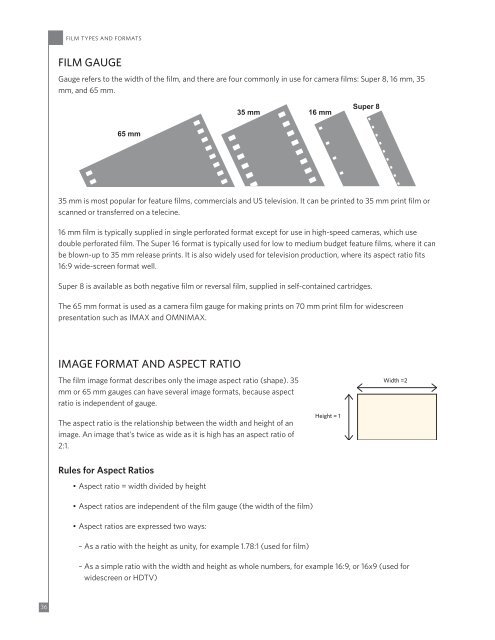Create successful ePaper yourself
Turn your PDF publications into a flip-book with our unique Google optimized e-Paper software.
36<br />
<strong>FILM</strong> <strong>TYPES</strong> <strong>AND</strong> <strong>FORMATS</strong><br />
<strong>FILM</strong> GAUGE<br />
Gauge refers to the width of the film, and there are four commonly in use for camera films: Super 8, 16 mm, 35<br />
mm, and 65 mm.<br />
65 mm<br />
35 mm is most popular for feature films, commercials and US television. It can be printed to 35 mm print film or<br />
scanned or transferred on a telecine.<br />
16 mm film is typically supplied in single perforated format except for use in high-speed cameras, which use<br />
double perforated film. The Super 16 format is typically used for low to medium budget feature films, where it can<br />
be blown-up to 35 mm release prints. It is also widely used for television production, where its aspect ratio fits<br />
16:9 wide-screen format well.<br />
Super 8 is available as both negative film or reversal film, supplied in self-contained cartridges.<br />
The 65 mm format is used as a camera film gauge for making prints on 70 mm print film for widescreen<br />
presentation such as IMAX and OMNIMAX.<br />
IMAGE FORMAT <strong>AND</strong> ASPECT RATIO<br />
The film image format describes only the image aspect ratio (shape). 35<br />
mm or 65 mm gauges can have several image formats, because aspect<br />
ratio is independent of gauge.<br />
The aspect ratio is the relationship between the width and height of an<br />
image. An image that’s twice as wide as it is high has an aspect ratio of<br />
2:1.<br />
Rules for Aspect Ratios<br />
• Aspect ratio = width divided by height<br />
• Aspect ratios are independent of the film gauge (the width of the film)<br />
• Aspect ratios are expressed two ways:<br />
35 mm 16 mm<br />
– As a ratio with the height as unity, for example 1.78:1 (used for film)<br />
Height = 1<br />
Super 8<br />
Width =2<br />
– As a simple ratio with the width and height as whole numbers, for example 16:9, or 16x9 (used for<br />
widescreen or HDTV)

















